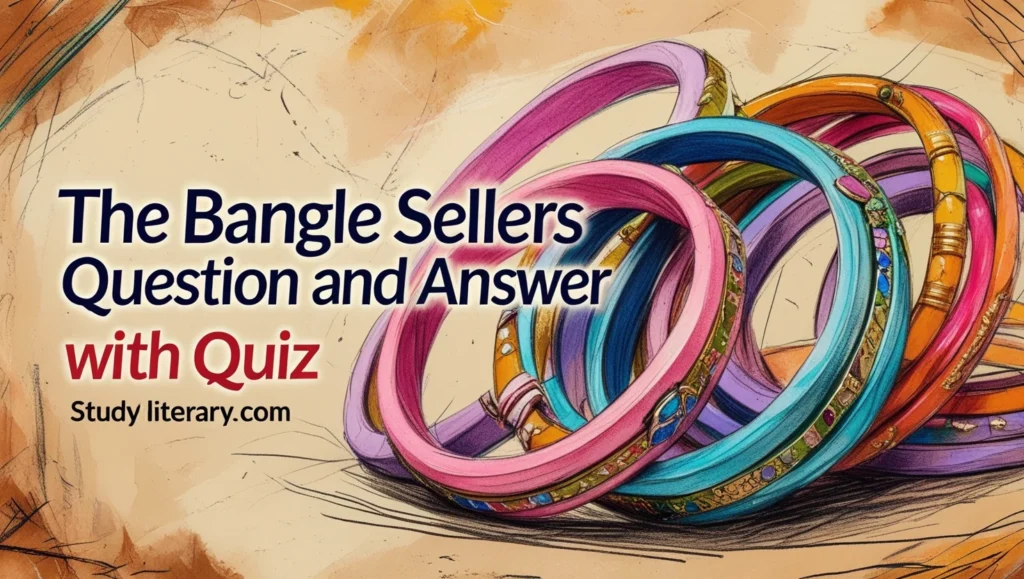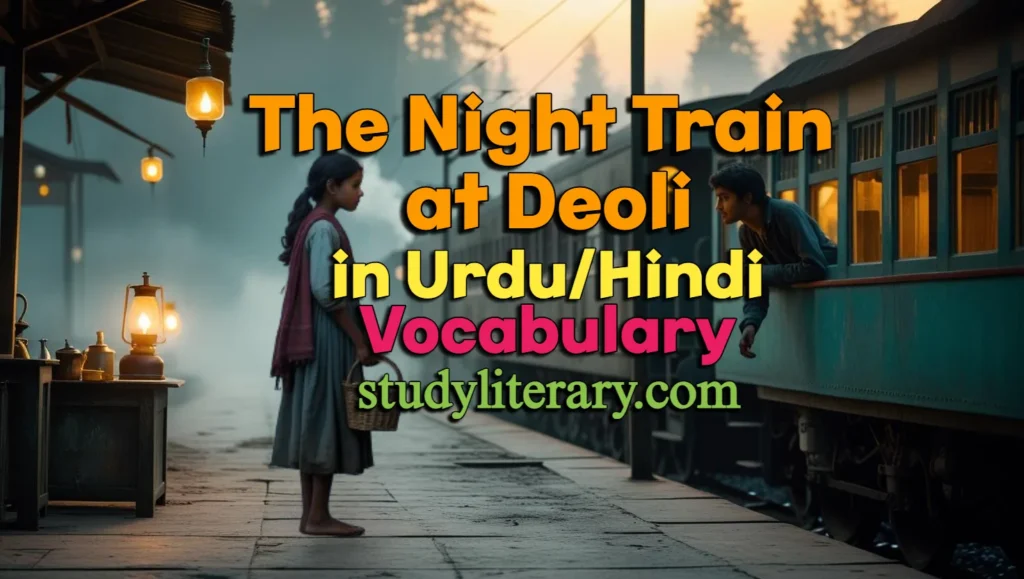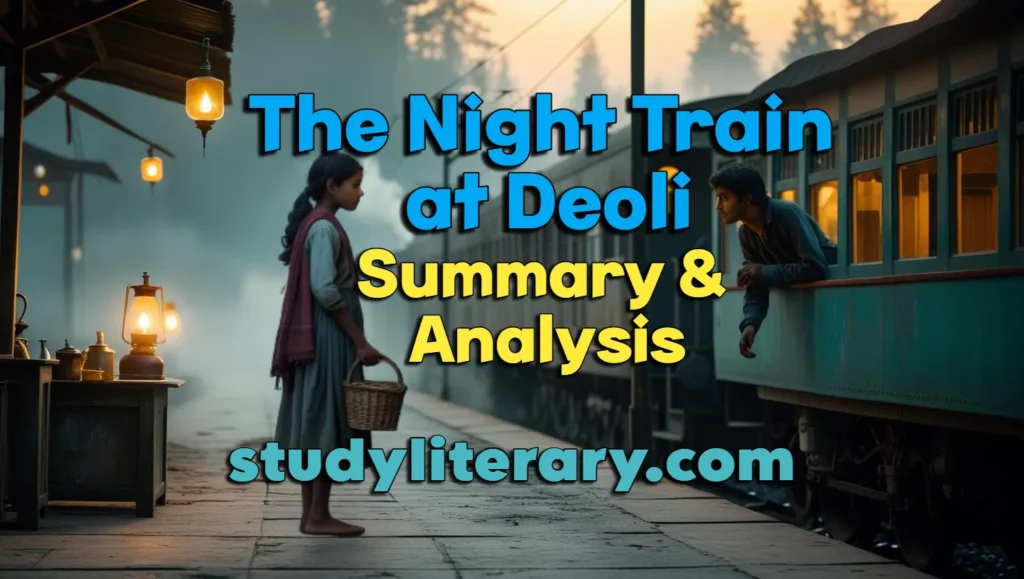
Table of Contents
ToggleTextual Question with Answer
1. What is the mood of the poem “The Bangle Sellers”?
a) Critical and questioning
b) Romantic and passionate
c) Happy and carefree
d) Melancholy and reflective
Correct answer: d) Melancholy and reflective
Explanation:
The poem is thoughtful and emotional. It reflects on the different stages in a woman’s life — from being a young girl, to a bride, and then a mother. It talks about both happy and serious moments. So the mood is reflective (thoughtful) and a little melancholy (gentle sadness mixed with love).
2. What is the significance of the bangles in the poem “The Bangle Sellers”?
a) They represent wealth
b) They symbolise Love and Marriage
c) They are a source of income for the sellers
d) They represent freedom
Correct answer: b) They symbolise Love and Marriage
Explanation:
In the poem, the bangles are not just jewelry. They stand for love, marriage, dreams, and the different roles of a woman. Each color and type of bangle shows a different time in a woman’s life, especially related to love and marriage.
Test Your Knowledge with our free Quiz
Textual Question
MCQs 1–10: Stanza 1 (Introduction & Purpose)
Who are the speakers in the poem?
A) Priests
B) Dancers
C) Bangle sellers
D) Women buyers
Answer: CWhere are the bangle sellers going?
A) Wedding house
B) Temple fair
C) Village market
D) City shop
Answer: BWhat are the bangle sellers carrying?
A) Clothes
B) Bright bangles
C) Flowers
D) Food
Answer: BWhat kind of bangles are described in the poem?
A) Wooden
B) Metal
C) Rainbow-tinted
D) Plain and simple
Answer: CThe phrase “circles of light” refers to:
A) The sun
B) Light bulbs
C) Bangles
D) Lamps
Answer: CWhat is the tone in the first stanza?
A) Sad
B) Angry
C) Joyful and inviting
D) Worried
Answer: CWhat kind of lives do the bangles represent?
A) Boring lives
B) Radiant lives
C) Difficult lives
D) Lonely lives
Answer: BWho are the bangles meant for?
A) Old women
B) Foreigners
C) Daughters and wives
D) Children only
Answer: CWhat does “lustrous tokens” mean?
A) Expensive gifts
B) Shiny symbols
C) Heavy items
D) Fragile toys
Answer: BWhich of the following words is used in the poem to describe bangles?
A) Dull
B) Rough
C) Delicate
D) Dark
Answer: C
MCQs 11–20: Stanza 2 (Bangles for Maidens)
What is the meaning of “maiden”?
A) Mother
B) Young unmarried girl
C) Widow
D) Old woman
Answer: BWhat colors are used to describe bangles for maidens?
A) Black and red
B) Purple and orange
C) Silver and blue
D) Yellow and green
Answer: CWhat natural element is used to describe the bangles’ color?
A) Rain
B) Fire
C) Mountain mist
D) Sea waves
Answer: CWhat is the tone of this stanza?
A) Sad
B) Playful
C) Dreamy and soft
D) Serious
Answer: CWhich comparison is used for maiden’s bangles?
A) Buds on woodland stream
B) Flames
C) Stars
D) Thunderclouds
Answer: AThe word “flushed” in “some are flushed like the buds” suggests:
A) Tiredness
B) Bright color
C) Anger
D) Sadness
Answer: BWhat kind of imagery is used in “tranquil brow of a woodland stream”?
A) Violent
B) Peaceful and calm
C) Dark and scary
D) Loud
Answer: BWhat do the buds in the poem symbolize?
A) Death
B) Sadness
C) Dreams of young girls
D) Married women
Answer: CThe line “silver and blue as the mountain mist” is an example of:
A) Hyperbole
B) Simile
C) Alliteration
D) Metaphor
Answer: BWhat does this stanza focus on?
A) The wedding ceremony
B) The bride
C) Young unmarried girls
D) Old women
Answer: C
MCQs 21–30: Stanza 3 (Bangles for Brides)
Which stage of a woman’s life is shown in this stanza?
A) Childhood
B) Widowhood
C) Bridal stage
D) Old age
Answer: CThe bangles for a bride are compared to:
A) Fire and stars
B) Sunlit corn
C) Ocean waves
D) Rain clouds
Answer: BWhat time is mentioned in “bridal morn”?
A) Night
B) Noon
C) Morning
D) Evening
Answer: CWhat is “bridal laughter” and “bridal tear” meant to show?
A) Bride’s fear
B) Bride’s mood swings
C) Mixed emotions of a bride
D) Bride’s sadness
Answer: CThe words “tinkling, luminous, tender, and clear” describe the bangles as:
A) Dull and broken
B) Noisy and dark
C) Shining and soft
D) Big and rough
Answer: CThe flame of the marriage fire refers to:
A) Cooking fire
B) Sacred fire of wedding
C) Anger
D) House fire
Answer: BWhat do the colors of bridal bangles show?
A) Pain
B) Simplicity
C) Love and desire
D) Loneliness
Answer: CThe bridal bangles show what type of feelings?
A) Only happiness
B) Only fear
C) Happiness and sadness
D) Confusion
Answer: CWhat does “hue of her heart’s desire” mean?
A) Color of her favorite food
B) Color of her dreams and wishes
C) Sadness of the heart
D) Darkness of soul
Answer: BBridal bangles are a symbol of:
A) End of childhood
B) Start of work life
C) Beginning of married life
D) Leaving home forever
Answer: C
MCQs 31–40: Stanza 4 (Bangles for Mothers / Middle Age)
Which color is used for older women’s bangles?
A) Purple and gold-flecked grey
B) Pink and white
C) Blue and black
D) Orange and red
Answer: AWho are the bangles for in this stanza?
A) Children
B) Maidens
C) Mothers and middle-aged women
D) Widows
Answer: CWhat does “journeyed through life midway” mean?
A) Died young
B) Lost in travel
C) Lived half of her life
D) Getting married
Answer: CWhat role do these women play in the family?
A) Serve as maids
B) Stay alone
C) Care for children and husbands
D) Go to work
Answer: C“Whose love has blest” shows the woman’s:
A) Pain
B) Anger
C) Caring and loving nature
D) Jealousy
Answer: C“Cradled fair sons” means she has:
A) Put sons in danger
B) Raised and cared for sons
C) Ignored children
D) Lost her children
Answer: BWhat kind of pride is mentioned?
A) Pride in wealth
B) Pride in beauty
C) Fruitful pride (of family and care)
D) False pride
Answer: CHow does the woman show her devotion?
A) Through silence
B) By fighting
C) By praying beside her husband
D) By leaving home
Answer: CWhat does the purple and grey color symbolize?
A) Death
B) Youth
C) Maturity and experience
D) Sadness
Answer: CThe tone in this stanza is:
A) Joyful and dreamy
B) Respectful and calm
C) Angry and loud
D) Lazy and dull
Answer: B
MCQs 41–50: Poem As A Whole – Theme, Style, Imagery
What is the main subject of the poem?
A) Indian culture
B) Festivals
C) Bangles and women’s life stages
D) Nature only
Answer: CWhat literary device is used in “like the flame of her marriage fire”?
A) Metaphor
B) Simile
C) Personification
D) Irony
Answer: BWhat do bangles represent in the poem?
A) Toys
B) Money
C) Stages of a woman’s life
D) Luxury
Answer: CWho wrote the poem?
A) Kamala Das
B) Sarojini Naidu
C) Rabindranath Tagore
D) Mahadevi Verma
Answer: BWhat is the tone of the overall poem?
A) Sad and painful
B) Angry and aggressive
C) Celebratory and respectful
D) Funny and playful
Answer: CWhat is the mood of the poem?
A) Depressed
B) Uplifting and emotional
C) Hopeless
D) Tense
Answer: BWhat poetic device is used in “tinkling, luminous, tender and clear”?
A) Personification
B) Alliteration
C) Onomatopoeia
D) Simile
Answer: BThe poem mainly highlights which culture?
A) Western
B) Tribal
C) Indian
D) African
Answer: CWhich of these is not a symbol used in the poem?
A) Sunlit corn
B) Mountain mist
C) Thunderstorm
D) Marriage fire
Answer: CWhat do the three stages of life shown in the poem represent?
A) Confusion
B) Rebirth
C) Womanhood
D) Freedom
Answer: C
MCQs 51–60: Tone, Language & Mood
What is the tone of the poem towards women’s roles?
A) Disrespectful
B) Neutral
C) Respectful and honoring
D) Doubtful
Answer: CWhich literary device is mostly used to describe colors and feelings in the poem?
A) Irony
B) Imagery
C) Allegory
D) Pun
Answer: BThe poem can best be described as a:
A) Ballad
B) Romantic epic
C) Lyric poem
D) Haiku
Answer: CWhat emotion does the line “Like her bridal laughter and bridal tear” express?
A) Confusion
B) Anger
C) Mixed emotions
D) Excitement
Answer: CThe overall mood of the poem is:
A) Sorrowful
B) Celebratory
C) Frightening
D) Lonely
Answer: BThe poet celebrates which aspect of Indian tradition?
A) Music
B) Cooking
C) Womanhood through bangles
D) Farming
Answer: C“Circles of light” is an example of:
A) Hyperbole
B) Metaphor
C) Simile
D) Paradox
Answer: BWhich poetic device is used in “tinkling, luminous, tender, and clear”?
A) Assonance
B) Simile
C) Repetition
D) Alliteration
Answer: DThe bangles are used as a symbol of:
A) Religious purity
B) Modern fashion
C) Stages of a woman’s life
D) Political power
Answer: CWhich season is most reflected in the poem’s imagery?
A) Autumn
B) Winter
C) Spring
D) Monsoon
Answer: C
MCQs 61–70: Imagery & Symbolism
Which natural element is not mentioned in the poem?
A) Fire
B) Mountain mist
C) Ocean tides
D) Sunlit corn
Answer: CThe phrase “woodland stream” suggests:
A) A wild storm
B) A deep sea
C) Calm and quiet nature
D) Fast flowing river
Answer: CWhat does the word “limpid” in “limpid glory” mean?
A) Dirty
B) Clear and pure
C) Rough
D) Broken
Answer: BThe phrase “newborn leaves” stands for:
A) Freshness and youth
B) Death and decay
C) Old age
D) Weakness
Answer: AThe bangle colors change based on:
A) Wealth of the woman
B) Region she lives in
C) Stage of life
D) Size of her hand
Answer: CWhich image best reflects a young girl in the poem?
A) Purple and grey
B) Sunlit corn
C) Mountain mist
D) Marriage fire
Answer: CThe bangle sellers represent:
A) Traders only
B) Voices of tradition
C) Family elders
D) Priests
Answer: B“Cradled fair sons” shows:
A) Happiness of raising children
B) Anger toward sons
C) Weakness in motherhood
D) Loneliness of mothers
Answer: AWhat does the “marriage fire” symbolize?
A) Housework
B) Cooking
C) Sacred rituals of wedding
D) Anger
Answer: CWhich phrase refers to both joy and sadness?
A) Cradled fair sons
B) Bridal laughter and bridal tear
C) Rainbow-tinted circles
D) Fruitful pride
Answer: B
MCQs 71–80: Character and Role Depictions
Who are the buyers in the poem assumed to be?
A) Men
B) Children
C) Women of all ages
D) Foreigners
Answer: CWhat role does the middle-aged woman play in her household?
A) Passive observer
B) Active caretaker and worshipper
C) Worker outside home
D) Rebel
Answer: BWhich line best reflects devotion in marriage?
A) Like her bridal laughter
B) Worships the gods at her husband’s side
C) Who will buy these bangles
D) Cradled fair sons
Answer: B“Fruitful pride” in the poem means:
A) Arrogance
B) Joy in farming
C) Pride in motherhood and care
D) Desire for money
Answer: CHow is the life of a married woman shown?
A) Painful
B) Joyful and meaningful
C) Short
D) Lazy
Answer: BThe poem honors:
A) Women in all life stages
B) Only young girls
C) Soldiers
D) Only rich women
Answer: AWho is the intended audience for the bangle sellers?
A) Foreign tourists
B) Men only
C) Indian women
D) Children
Answer: CWhich emotion is not clearly expressed in the poem?
A) Love
B) Pride
C) Hate
D) Joy
Answer: CThe poem gives special attention to:
A) Outer beauty
B) Daily life of men
C) Woman’s emotional and spiritual journey
D) Politics
Answer: CWhat is a “token” in the phrase “lustrous tokens of radiant lives”?
A) Small gift
B) Symbol or sign
C) Fruit
D) Number
Answer: B
MCQs 81–90: Poetic Devices & Language
“Silver and blue as the mountain mist” is a:
A) Simile
B) Metaphor
C) Irony
D) Hyperbole
Answer: A“Flushed like the buds” shows use of:
A) Metaphor
B) Simile
C) Symbolism
D) Irony
Answer: B“Tinkling, luminous, tender” uses:
A) Simile
B) Alliteration
C) Metaphor
D) Pun
Answer: BWhich sound-related word appears in the poem?
A) Echoing
B) Tinkling
C) Screaming
D) Barking
Answer: BWhat technique does Sarojini Naidu often use in her poems?
A) Satire
B) Harsh realism
C) Rich visual imagery
D) Minimalism
Answer: CIn the poem, bangles are described using words connected to:
A) War and violence
B) Food and drink
C) Nature and feelings
D) Buildings
Answer: C“Like her bridal laughter and bridal tear” uses:
A) Metaphor
B) Simile
C) Alliteration
D) Hyperbole
Answer: BThe phrase “limpid glory of newborn leaves” combines:
A) Nature and emotion
B) Anger and hatred
C) Hunger and thirst
D) Richness and money
Answer: AWhich poetic technique gives the poem a musical feel?
A) Free verse
B) Rhyme and rhythm
C) News-style language
D) Dialogue
Answer: BThe poem is an example of a:
A) Sonnet
B) Limerick
C) Lyrical narrative
D) Blank verse
Answer: C
MCQs 91–100: Interpretation & Values
The poem reflects values of:
A) Western feminism
B) Traditional Indian culture
C) Street fashion
D) Political power
Answer: BThe poem encourages us to see:
A) Women as weak
B) Bangles as luxury
C) Deep meaning in everyday things
D) Traditions as outdated
Answer: CBangles are presented as:
A) Useless items
B) Sacred and emotional symbols
C) Toys for children
D) Dangerous objects
Answer: BThe poem honors which part of society?
A) Businessmen
B) Teachers
C) Indian women
D) Farmers
Answer: CThe poet’s view of marriage is:
A) Negative
B) Unimportant
C) Scared and emotional
D) Forced tradition
Answer: C“Temple fair” represents:
A) A political event
B) A religious gathering
C) A war scene
D) A funeral
Answer: BWhat does the repetition of the word “some” suggest?
A) Anger
B) Variety in bangles
C) Rejection
D) Boredom
Answer: BThe use of color imagery in the poem creates:
A) Boredom
B) Confusion
C) Beauty and emotion
D) Comedy
Answer: CThe poet’s message about women is:
A) That they should be silent
B) That they live meaningless lives
C) That every stage of a woman’s life is beautiful
D) That they are forced into roles
Answer: CThe poem ends by honoring:
A) Widows
B) Old age
C) Married, devoted women
D) Single girls
Answer: C
MCQs 101–125: Comprehensive Appreciation
Sarojini Naidu is also known as:
A) Nightingale of India
B) Warrior of India
C) Queen of Bengal
D) Flower of Mumbai
Answer: AThe poem shows that bangles reflect:
A) Social status
B) Inner beauty and roles of women
C) Price tags
D) Number of children
Answer: BHow many stages of life are shown in the poem?
A) 2
B) 3
C) 5
D) 4
Answer: BWhat age groups are represented in the poem?
A) Children and men only
B) Girls, brides, and middle-aged women
C) Boys and mothers
D) Only old women
Answer: BThe most common comparison used is with:
A) Machines
B) Waterfalls
C) Natural elements
D) Money
Answer: CThe phrase “temple fair” implies:
A) A festival full of tradition and culture
B) A business event
C) A war zone
D) A market only
Answer: AThe poem connects bangles to:
A) Modern clothes
B) Global politics
C) Emotional and spiritual growth
D) Urban life
Answer: CSarojini Naidu uses bangles to reflect:
A) Wealth
B) Rebellion
C) Indian womanhood
D) Sadness
Answer: CWhich quality is not celebrated in the poem?
A) Devotion
B) Pride
C) Laziness
D) Love
Answer: CThe poem was written during:
A) Pre-independence India
B) British rule
C) Modern day
D) Post-independence
Answer: BWhich of these themes is central to the poem?
A) Freedom struggle
B) Feminine beauty and strength
C) Animal rights
D) Sports and games
Answer: BWhat does the poem say about life stages?
A) Only childhood matters
B) Each stage is meaningful
C) Life is boring
D) Life is unfair
Answer: B“Delicate, bright” shows the bangles are:
A) Rough and strong
B) Fragile and colorful
C) Cheap and fake
D) Dark and dull
Answer: BThe poem uses how many stanzas?
A) Two
B) Four
C) Five
D) Six
Answer: BWhat do all stanzas have in common?
A) All describe war
B) All describe a man
C) All celebrate womanhood
D) All have the same rhyme
Answer: CThe poet’s attitude is one of:
A) Criticism
B) Celebration and respect
C) Mockery
D) Confusion
Answer: BWhich of these is not a poetic device used in the poem?
A) Simile
B) Imagery
C) Oxymoron
D) Alliteration
Answer: CThe poem ends with which idea?
A) Youthfulness
B) Maturity, duty, and devotion
C) Death
D) War
Answer: B“Radiant lives” means:
A) Dull lives
B) Beautiful and bright lives
C) Strange lives
D) Sad lives
Answer: BThe poem’s cultural focus is on:
A) Western lifestyle
B) Urban living
C) Traditional Indian roles
D) Space and technology
Answer: CBangles for brides show:
A) Only tears
B) Strong emotions and hopes
C) End of freedom
D) Isolation
Answer: BWhat is the role of repetition in the poem?
A) To confuse the reader
B) To build rhythm and emphasize points
C) To fill space
D) To add noise
Answer: BWhat does the poem suggest about motherhood?
A) It is painful
B) It is a source of pride and love
C) It is ignored
D) It is tiring
Answer: BWhy is this poem famous?
A) It is short
B) It’s written by a freedom fighter
C) It celebrates Indian womanhood beautifully
D) It is translated from Sanskrit
Answer: CWhat is the best one-word theme for the poem?
A) Power
B) Struggle
C) Womanhood
D) Death
Answer: C
Quiz
Attempt STUDYLITERARY Quiz for absolutely free!
Share
- Facebook
- Twitter
- Linkedin
- Whatsapp
- Pinterest
- Telegram


